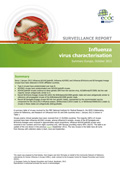# 6784
The only constant with influenza viruses is their ability to change over time. Since immune systems can learn to recognize and defeat previously seen viral infections, they would soon run out of susceptible hosts if they could not continually evolve.
Most of the time, these changes are incremental, and are due to a process called Antigenic drift. Drift comes about due to replication errors that are common with single-strand RNA viruses.
Over time these minor changes can accumulate to the point that previously infected immune systems will fail to recognize it, giving the virus a fresh supply of hosts.
NIAID has a nice 3-minute video illustrating the process, which you can view on their Youtube Channel or in the box below.
So, while we talk about seasonal A/H3N2 or A/H1N109 as if they are single entities, in truth, there are a good many minor variations on each theme circulating around the world.
Within each strain, we can see numerous `clades’, or genetically distinct groups. We watch the formation, and progress of these clades carefully, since they may eventually require a change in the flu vaccine’s formulation.
Roughly once a month the ECDC releases an influenza virus characterization report, providing laboratory analysis of recently collected flu virus samples across Europe. Collection dates only extend through week 39, but this latest ECDC report indicates continued diversity among the viruses in circulation.
The vast majority of flu viruses identified (68%) were of the type A/H3N2. Relatively few A/H1N1 viruses were collected.
Among the influenza B viruses received, samples were pretty evenly divided between the Victoria lineage (included in last year’s vaccine) and the Yamagata lineage (part of this year’s vaccine).
Here’s the link to their report, and the abstract.
Influenza virus characterisation - Summary Europe, November 2012
Surveillance reports - 14 Dec 2012
Available as PDF in the following languages:
ABSTRACT
During the 2011/2012 season, A(H1N1)pdm09, A(H3N2) and B/Victoria and B/Yamagata lineage influenza viruses, with collection dates between 1 January and 30 September 2012 (weeks 1–39), have been detected in ECDC-affiliated countries.
- Type A viruses predominated over type B.
- A(H3N2) viruses predominated over A(H1N1)pdm09 viruses.
- A(H1N1)pdm09 viruses continued to show genetic drift from the vaccine virus, A/California/07/2009, but the vast majority remained antigenically similar to it.
- Antigenic drift of A(H3N2) viruses compared to the A/Perth/16/2209 vaccine virus resulted in a recommendation to change to an A/Victoria/361/2011-like component for the 2012/2013 influenza season.
- B/Victoria lineage viruses fell within the B/Brisbane/60/2008 genetic clade and were antigenically similar to reference cell-propagated viruses of the B/Brisbane/60/2008 genetic clade.
- Recent B/Yamagata-lineage viruses fell into two genetic clades in approximately equal proportions: clade 3 represented by the recommended vaccine component for the 2012/2013 influenza season, B/Wisconsin/1/2010, and clade 2 represented by B/Estonia/55669/2012. Viruses in each clade are antigenically distinguishable.
The split between clade 2 and clade 3 of the Yamagata B virus lineage bears watching, and A/H3N2 shows the most variety with samples falling into 5 distinct genetic groups.
The good news, despite this growing diversity among flu viruses, is that the majority of those collected in Europe through week 39 still appear antigenically similar to this year’s vaccine strains.
Related Post:
Widget by [ Iptek-4u ]


